Hassani S. Mathematical Physics: A Modern Introduction to Its Foundations
Подождите немного. Документ загружается.


26.5
EXTERIOR
CALCULUS
793
Each
component
of dFvanishes becauseof Maxwell's
equations.
III
The example above shows that
26.5.6. Box.
The two homogeneous Maxwell's equations can be written as
dF = 0, where F is definedby Equation (26.37).
The exterior derivative is a very useful concept in the theory of differential
forms, as illustrated in the preceding example. However. that is not the only dif-
ferentiation available to the differential forms. We have already defined the Lie
derivative for arbitrary tensors. Sincedifferential forms are (antisymmetrized) lin-
ear combinations
of
covariant
tensors, Lie differentiation is definedfor themas
well. In fact, since differential forms have no contravariant parts, one uses the
pullback map
F,*
in the definition
of
the Lie derivative instead
of
F,-;'
1.
*
-1
d *
Lxw
=
(F,)
-F,
w.
dt
(26.38)
interior
product
ofa
vector
field
and
a
differential
form
The two derivatives defined so far have the following convenient property,
whoseproofis left asanexercise forthe
reader:
26.5.7.
Theorem.
The exterior derivative d is natural with respect to
Lx
(or
commutes with l-x)for X E
X(M);
that is, d 0
Lx
= Lx:0 d.
In our definition of exterior product in the previous chapter, we assumed that
the number
of
vectors was equal to the numberof linearfunctionals takenfrom the
dual space [see Equation (25.9)]. As a result of this complete pairing, we always
ended up with a number.
It
is useful, however, to define an "incomplete" pairing
in whicb the number
of
vectors and dual vectors are not the same. In particular,
if
we have a
p-fonn
and a single vector field, then we can pairthe vector field with
one
of
the factors of the
p-fonn
to get a (p - I)-fonn. This process is important
enough to warrant the following:
26.5.8. Definition.
Let X bea vectorfield and w a p-form ona manifold M. Then
define
ix:
AP(M)
~
AP-l(M)
by
iXW(Xl,
...
,
Xp-l)
=
w(X,
Xl,
...
,
Xp-l).
If
w E Ao(M), i.e.,
if
w is just a function, we set
ixw
=
O.
ixw
is called the
interiorproductor contraction
of
X and w. Another notation commonly usedfor
ixw
isXJw.
Although no signature of "differentiation" appears on
ix,
it does have such a
property:
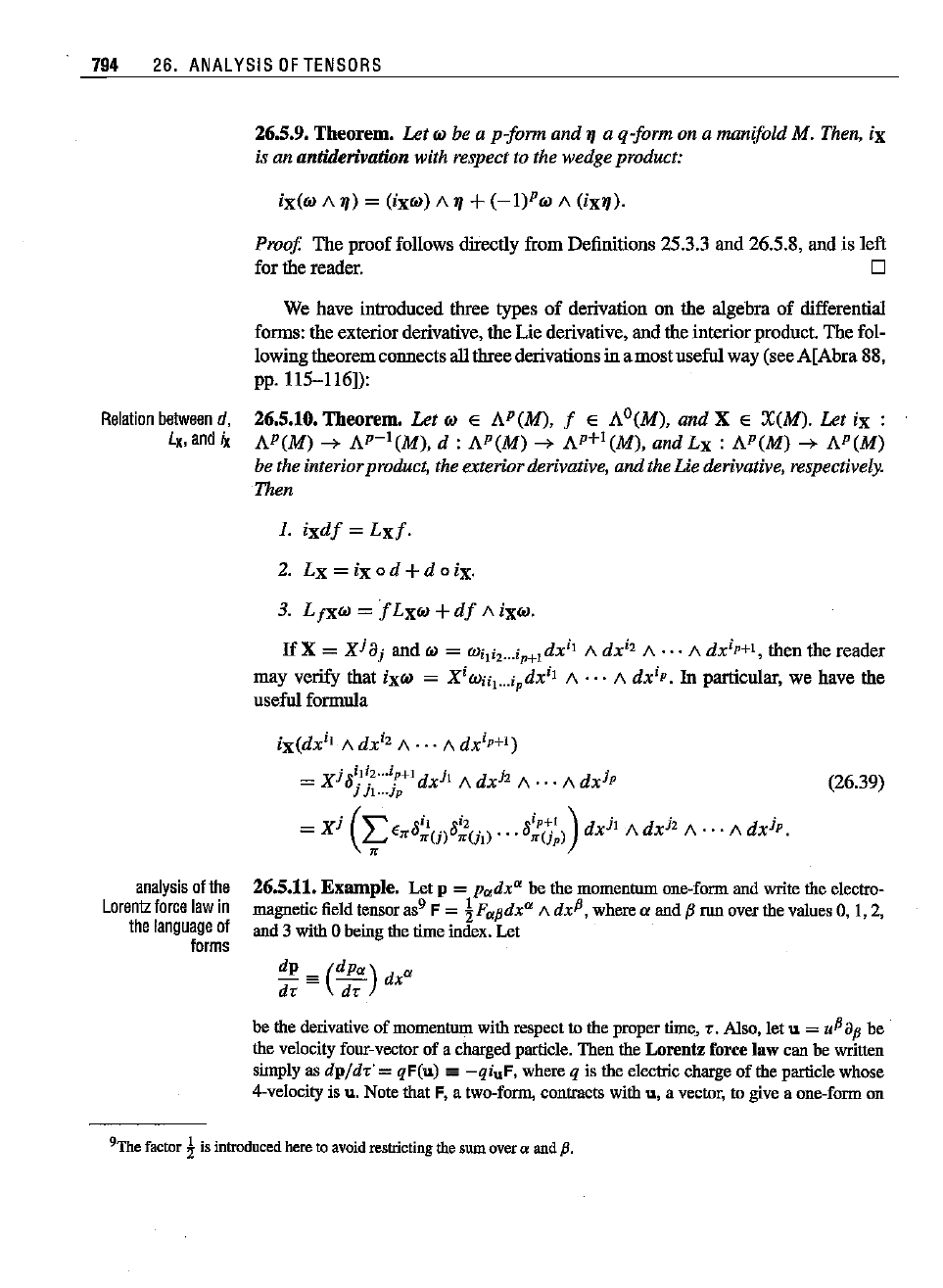
794 26.
ANALYSIS
OF
TENSORS
26.5.9.
Theorem.
Let w be a p-form
and
1/a q-form on a manifoldM. Then,
ix
is an antiderivation with respect to the wedge product:
ix(w
A 1/) =
(ixw)
A 1/+
(-I)P
w A (iX'l).
Proof.
The
proof
follows directly from Definitions 25.3.3
and
26.5.8, and is left
for the reader. D
Relation
between
d,
Lx,
and
ix
We have introduced three types
of
derivation on the algebra
of
differential
forms: the exterior derivative, the Lie derivative, and the interiorproduct. The fol-
lowingtheoremconnects all threederivations
in a
most
usefulway (see A[Abra 88,
pp. 115-116]):
26.5.10.
Theorem.
Let w E
AP(M),
f E AO(M),
and
X E
X(M).
Let ix :
AP(M)
--->
AP-l(M),
d :
AP(M)
--->
AP+l(M),
and
Lg
:
AP(M)
--->
AP(M)
betheinteriorproduct,theexteriorderivative, andtheLie derivative, respectively.
Then
1.
ixdf
=
Lxf.
2.
Lx
=
ix
0 d +d 0 ix.
3.
Lfxw
=
fLxw+df
Aixw.
If
X =
Xi
8j and w =
Wili2
..
.ip+ldxil
A
dX
i2
1\
...
A
dx
ip
+1 , then the reader
may
verify that
iXfd
=
XiWiil
...
ipdxil
A···
A dxip.
In
particular, we have the
useful formula
ix(dx
il
A dX
i2
A
...
A dxip+I)
=
Xi
aj.li.z
...
i~+ldxh
A.dx h A
...
A
dx
ip
}
}l
..•l p
x!
(",
,il
,i2
,ip+I
) d h d jz d j
=
~
€1tu
1r
(j
)u
1f
(h )
...
utr(jp) X A x
A···
/\
X p.
(26.39)
analysis
of
the
Lorentz
force
law
In
the
language
of
forms
26.5.11.
Example.
Let p = Padxa be the momentumone-formand write the electro-
magneticfield tensoras
9
F
=
!F
a/3dx
U
A dx
fJ
,wherea and
f3
run overthe values0, 1,2,
and3 with0 beingthe time index.Let
dp
==
(dPa)
dx
a
dt
dr
be the derivative of momentumwith respectto the proper time,
r.
Also,let u = uP
8p
be
the velocityfour-vector of a chargedparticle. Then the
Lorentz force law can be written
simptyas
dp/dr'
= qF(u)
==
-qiuF,
wbere q is the etectriccharge of the particlewhose
4-velocityis u. Note that F.a two-form, contracts with u, a vector,to give a one-formon
9The factor
~
is introduced here to avoid restricting the sum overa and p.
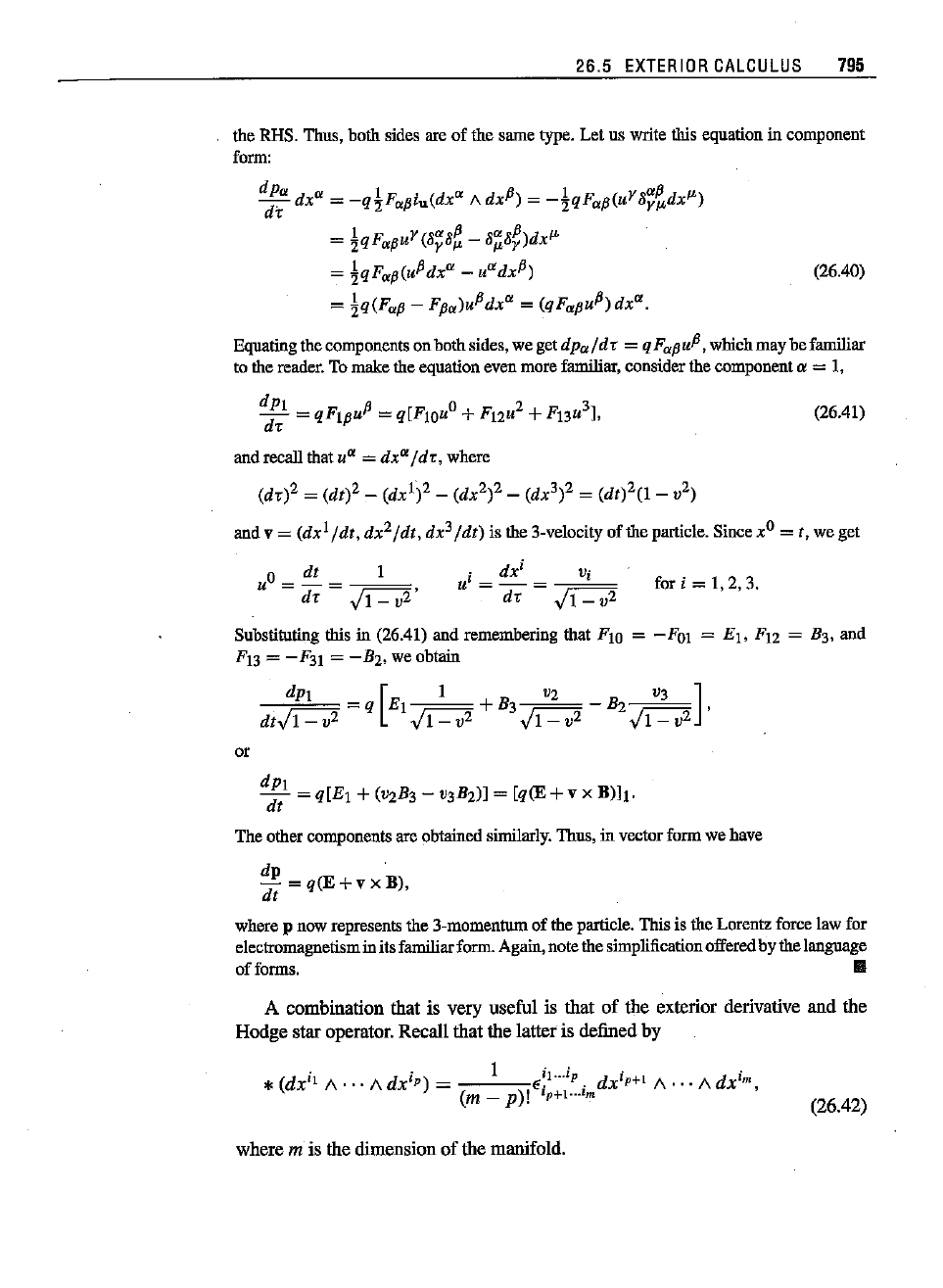
(26.40)
(26.41)
26.5
EXTERIOR
CALCULUS
795
theRHS.
Thus,
bothsides
are
of the sametype.Letus writethis
equation
in
component
form:
d;'u
dxu
=
-q!Fupiu(dxU
AdxP)
=
-tqFup(uY8~~dx")
=
tqFupuY(8~8t
-
8~8~)dx"
=
tqFup(uPdxU
- uUdx
P)
=
tq(Fup
- Fpu)uPdx
U
=
(qFupuP)dx
u.
Equating thecompnnents onbothsides,weget
dpu/dT
= qFupu
P,
wbicbmaybefamiliar
tothe
reader.
To
make
the
equation
even
more
familiar,
consider
the
component
a = 1,
dPl
• 0 2 3
aT
=
qFlpU"
= q[FlOu +F12
U
+
F13
U
i.
and
recall
that
u
Cl
= dx
Ol
[d-e,
where
(dT)2 = (dt)2 _ (dx
l)2
_ (dx
2)2
_ (dx
3)2
=
(dt)2(1_
v
2)
andv =
(dx1/dt,
dx
2/dt,
dx
3/dt)
is the 3-velocity ofthe particle.Sincex
O
= t, weget
° dt
u
=-
dT
I
i dx
i
Vi
u
=-=,,~=
dT
)1-
v
2
fori =
1,2,3.
Substituting this in (26.41) and remembering that FlO = -FQ1 =
El'
Fl2 = B3' and
F13
= - F3l =- B2' wenbtain
dpl
[I
V2
vs
]
-~~'"
=q
El
+ B3 - B2 ,
dt)l-
v
2
)1-
v
2
)1
- v
2
)1
- v
2
or
dp;
at
=
q[El
+
(V2
B3
-
V3
B2)]
= [q(E +v x B)lt·
The
other
components
are
obtained
similarly.
Thus,
in
vector
form
wehave
dp
.
dt
=
q(E
+v x B),
wherep now
represents
the
3-rnomentum
of the
particle.
Thisis the
Lorentz
forcelawfor
electromagnetism
initsfamiliarform.Again,notethe
simplification
offered
bythe
language
of
fnrms.
III
A combination that is very useful is that of the exterior derivative and the
Hodge star operator. Recall that the latteris defined by
. . 1 I}
l'
.
*
(dx"
A···
A dx
'p
)
= E
....
p.
dx'r"
A···/\
dx'»;
(m _ p)!
lp+l
...lm
where m is the dimension of the martifold.
(26.42)
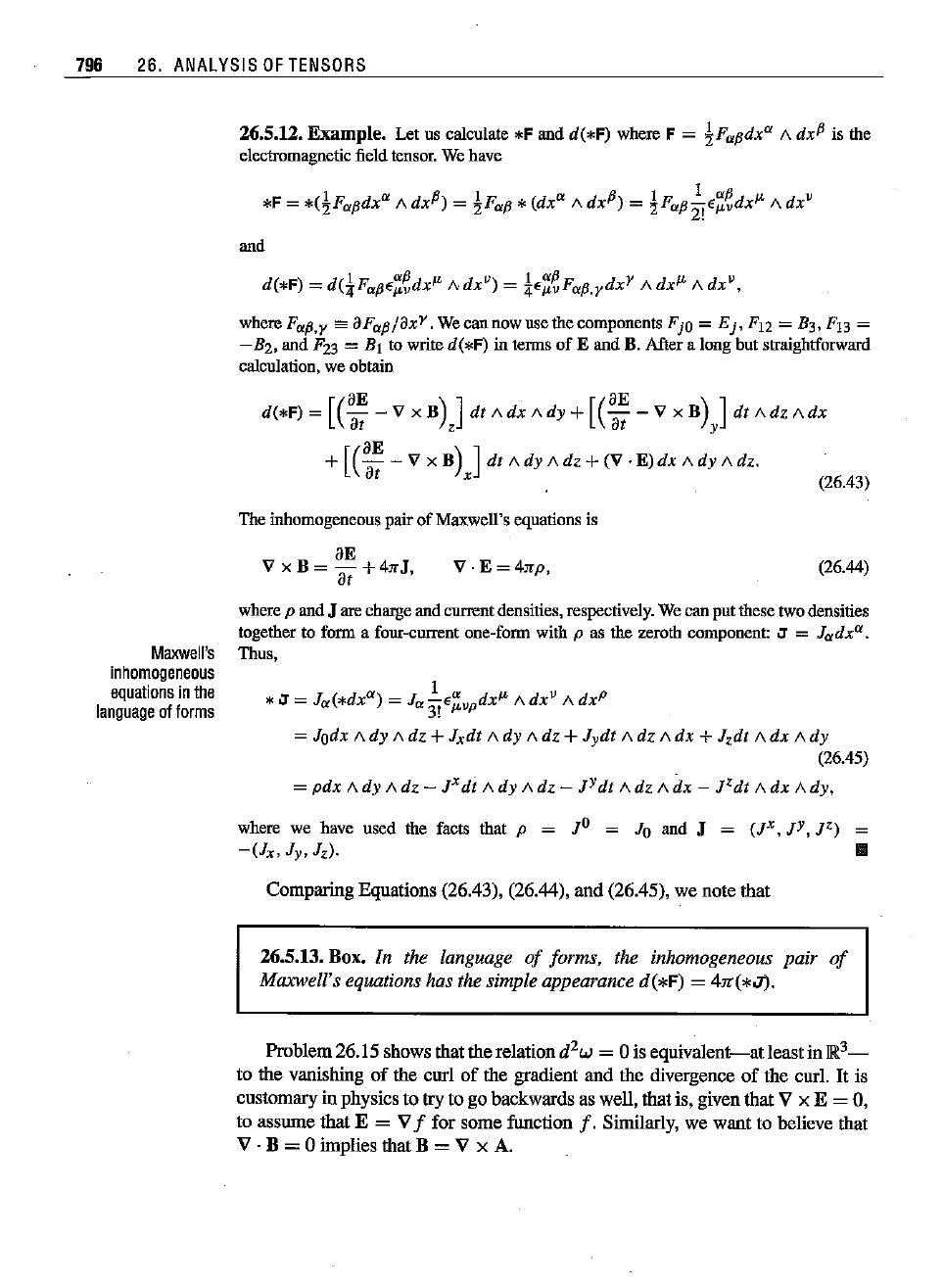
(26.43)
796 26.
ANALYSIS
OF
TENSORS
26.5.12.
Example.
Let us calculate *F and d(*F) where F =
!Fapdx
a
A dx
P
is the
electromagnetic
field
tensor.
Wehave
*F =
*(!Fapdx
a
Adx
P)
=
!FaP
* (dx
a
/\
dx
P)
=
~Fap~E~~dx"
A
dx"
and
d(*F) =
d(~FaPE~~dx"
Adx")
=
~E~~Fap.ydxY
/\
dx"
A
dx",
where
Fa[j,y eaaFap/ax
Y.
Wecannowusethecomponents
FjO
=
E],
F12
= B3.
F13
=
-H2,
and
F23
= Ht to writed(*F) in termsof E and B. Aftera lougbut straightforward
calculation, we
obtain
d(*F) =
[(~~
- Vx
B)J
dt rcdx
Ady
+
[(~~
- Vx
B)J
dt
Adz
rvdx
+
[(~~
- V x
B)J
dt
Ady
Adz+
(V
.E)dx
Ady
Adz.
The
inhomogeneous
pairof Maxwell's
equations
is
aE
VxB=-+4rrJ,
at
V·
E = 4rrp, (26.44)
Maxwell's
inhomogeneous
equations
In
the
language
of
forms
where
p
and
J
are
charge
and
current
densities,
respectively.
Wecanputthesetwodensities
together to form a four-current one-form with p as the zeroth component: J =
Jadx(X.
Thus,
1
*J =Ja(*dx(X) = Jo
3!€~vpdX~
A
dx"
A dx
P
=~bA~A~+h&A~A~+~&A~Ab+~&AbA~
(26.45)
=
pdx
Ady
Adz
-
Pdt
Ady
Adz
-
JYdt
Adz
rvdx - JZdt r-
dx
Ady,
where we have used the facts that p = JO = Jo and J =
(J
x
,
JY, JZ)
-(1x,
J
y,
Jz). III
Comparing Equations (26.43), (26.44), and (26.45), we note that
26.5.13. Box.
In the language
of
forms, the inhomogeneous pair
of
Maxwell's equations has the simple appearance
d(*F)
= 4".(*.1).
Problem26.15 shows that the relation d
2
w = 0 is
equivalent-at
leastin
rn:.
3
_
to the vanishing
of
the carl
of
the gradient and the divergence
of
the cnrl.
It
is
customaryin physics to try to go backwards as well, thatis, given that V x E
= 0,
to assume that E
= Vf for some function
f.
Similarly, we want to believe that
V·
B = 0 implies
thatB
= V x A.
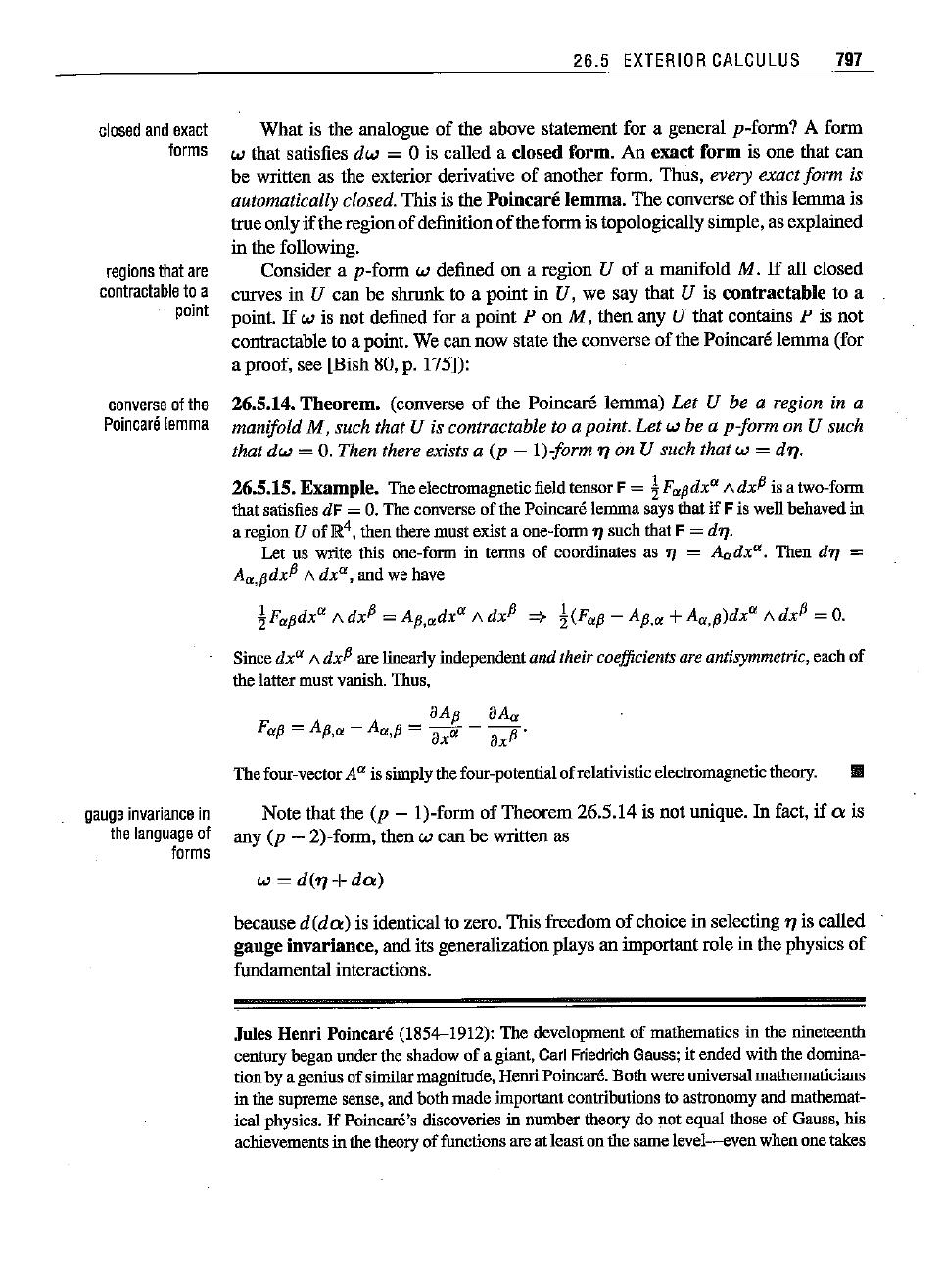
closed
and
exact
forms
regions
that
are
contractable
toa
point
converse
ofthe
Poincare
lemma
gauge
invariance
in
the
language
of
forms
26.5
EXTERIOR
CALCULUS
797
What is the analogue
of
the above statement for a geueral p-form? A form
w that satisfies
dw
= 0 is called a closed form. An exact
form
is one that can
be written as the exterior derivative of another form. Thus, every exact form is
automatically closed. This is the
Poincare
lemma. The converse of this lemma is
true only
if
the region
of
definition
of
theform is topologically simple, as explained
in the following.
Consider a p-form
w defined on a region U of a manifold M.
If
all closed
curves in
U can be shrunk to a point in U, we say that U is
contractable
to a
point.
If
w is not defined for a point P on M, then any U that contains P is not
contractable to a point. We can now state the converse of the Poincare lemma (for
a proof, see [Bish 80, p. 175]):
26.5.14.
Theorem.
(converse
of
the poincare lemma) Let U be a region in a
manifold M, such that U is contractable to a point.
Let
w be a p-form on U such
that
dw
=
O.
Then there exists a (p - I)-form '1 on U such that w =
dn.
26.5.15.
Example.
The electromagnetic field tensor F = !Frtpdx
ct
/\.dx
P
is a two-form
that satisfies dF =
O.
The converse
of
the Poincare
lemma
says that if F is wellbehaved in
a region U of
lR.
4
,
then there
must
exist a one-form
TJ
such
that F = d'l].
Let us write this one-form in terms of coordinates as
T1
=
Aadx
rt
•
Then
dTJ
=
Aa,pdx
fJ
/\
dx",
and we have
!F.pdx·
f\dx
P
=
Ap,.dx·
f\ dx
P
=}
!(F.p
-
Ap,.
+
A.,p)dx·
f\ dx
P
=
O.
Since
dx"
A
dx
fJ
are linearly independentand their coefficients are antisymmetric, each
of
the latter must vanish. Thus,
The
four-vectorAa is simply the four-potential
of
relativisticelectromagnetictheory.
II
Note that the
(p
- I)-form of Theorem 26.5.14 is not unique.
In
fact, if a is
any
(p - 2)-form, then w can be written as
w
= d('1 +
da)
because
d(da)
is identical to zero. This freedom of choice in selecting '1 is called
gange invariance, and its generalization plays an important role in the physics
of
fundamental interactions.
Jules
Henri
Poincare
(1854-1912):
The
development
of
mathematics in the nineteenth
century began under the shadow
of
a giant, Carl FriedrichGauss; it
ended
with the domina-
tionby a genius
of
similarmagnitude, Henripoincare.
Both
wereuniversalmathematicians
in the supreme sense, and
both
made
important contributions to astronomy and mathemat-
ical physics.
If
Poincare's discoveries in number theory do not equal those
of
Gauss, his
achievementsin the theory
of
functions are at
least
on the same
level-even
when
one takes
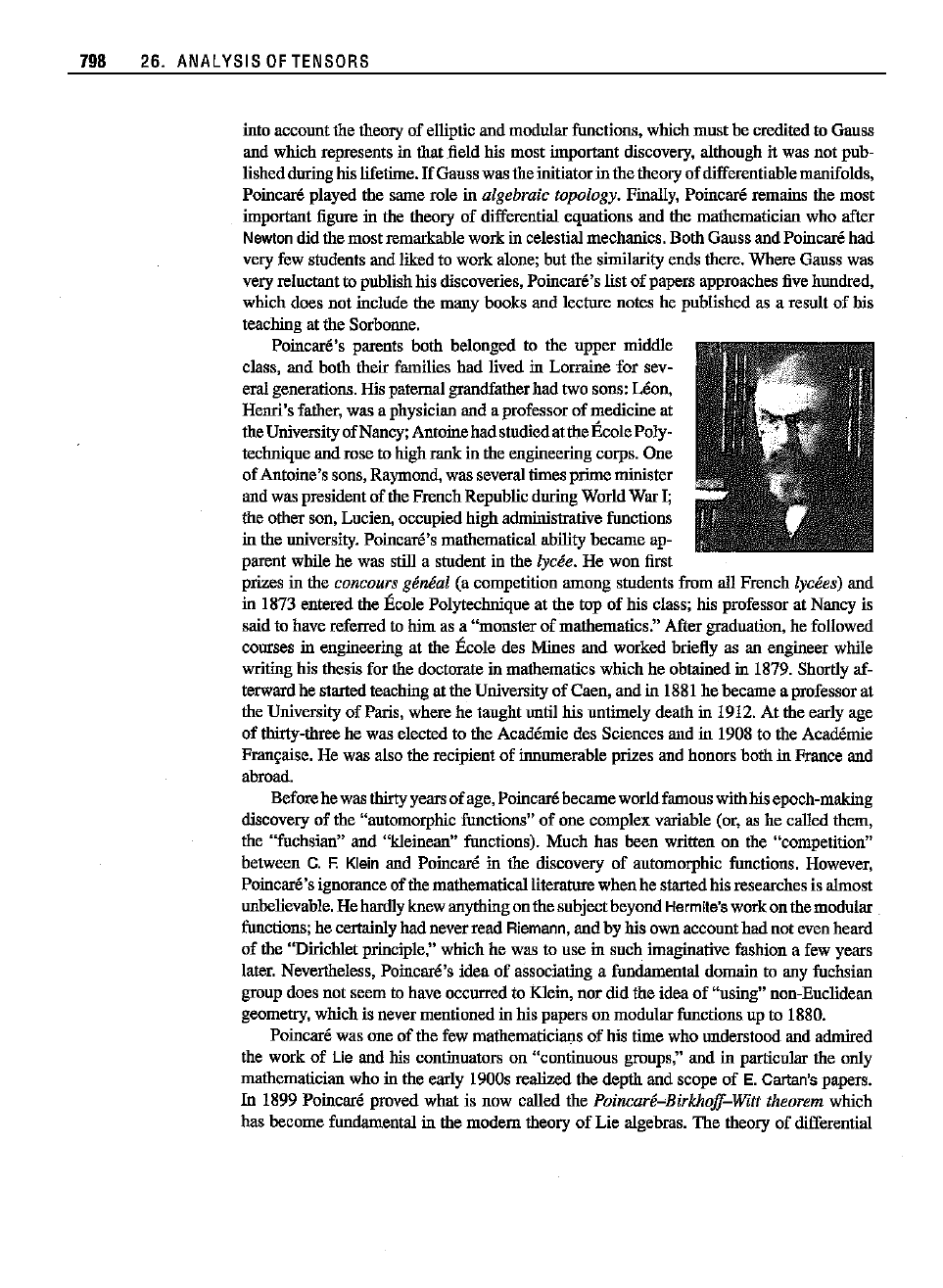
798 26. ANALYSIS
OF
TENSORS
into
account
the theory
of
elliptic
and
modular
functions, which
must
he credited to
Gauss
and which represents in thatfield his most important discovery, although it was not pub-
lished
duringhis lifetime.
If
Gausswas the initiatorin
the
theory
of
differentiablemanifolds,
poincare
played
the
same
role
in algebraic topology. Finally, Poincare remains the
most
important figure in the theory
of
differential
equations
and
the mathematician
who
after
Newtondid the
most
remarkable
work
in celestial mechanics.
Both
Gauss
and
poincare
had
veryfewstudentsandlikedto work alone;but thesimilarityendsthere.WhereGausswas
very reluctant to publishhis discoveries, Poincare's
list
of
papers
approaches five hundred,
which
does
not
include the
many
books
and
lecture notes he published as a result
of
his
teachingat the Sorbonne.
Poincare's
parents
both
belonged
to the
upper
middle
class,
and
both
their families
had
lived in Lorraine
for
sev-
eral generations. His paternal grandfather
had
two sons: Leon,
Henri's
father, was a physician and a professor
of
medicine
at
the University
of
Nancy; Antoinehadstudiedat the
Ecole
Poly-
technique
and
rose
to
high
rank
in the engineering corps.
One
of
Antoine's
sons, Raymond, was severaltimes
prime
minister
and was president
of
the
French
Republic
dnring
World
War
I;
the
other
son, Lucien,
occupied
high
administrative functions
in the university. Poincare's mathematical ability
became
ap-
parent
while
he was still a student in the lycee, He
won
first
prizes in the
concours
genial (a competition
among
students from all
French
lycees)
and
in 1873
entered
the Ecole
Poly
technique at the
top
of
his class; his
professor
at
Nancy
is
said
to have referred to
him
as a
"monster
of
mathematics."
After
graduation, he followed
courses in engineering at the
Ecole
des
Mines
and
worked
briefly as an
engineer
while
writing his thesis for the doctorate in mathematics
which
he
obtained
in 1879.
Shortlyaf-
terwardhe startedteaching at the University
of
Caen,
and
in 1881 he
became
a professor at
the University
of
Paris, where he
taught
until his
untimely
death
in 1912.
At
the early age
of
thirty-three he was elected to the Academte des
Sciences
and in 1908 to the Academic
Francaise. He was also the recipient
of
innumerable prizes and honors
both
in France and
abroad.
Beforehe was
thirty years
of
age, poincare
became
world
famous
with
his epoch-making
discovery of the "automorphic functions"
of
one
complex
variable (or. as he called them,
the
"fuchsian"
and
"kleinean" functions).
Much
has
been
written on the "competition"
between
C.
F.
Klein
and
poincare
in the discovery
of
automorphic functions. However,
Poincare's
ignorance
of
the
mathematical
literature
when
he startedhis researches is almost
unbelievable. He hardly
knew
anythingon the
subject
beyond
Hermite's
work
on the
modular
functions; he certainly
had
never
read
Riemann,
and
by his
own
account
had
not
even
heard
of
the "Dirichlet principle,"
which
he was to
use
in
such
imaginative fashion a few years
later. Nevertheless, Poincare's
idea
of
associating a fundamental
domain
to any fuchsian
group
does
not
seem
to have occurred to Klein.
nor
did
the
idea
of
"using"
non-Euclidean
geometry,
which
is never mentioned in his
papers
on
modular
functions up to 1880.
Poincare was one
of
the few mathematicians
of
his
time
who
understood and admired
the
work
of
Lie and his continuators on
"continuous
groups."
and
in particular the
only
mathematician
who
in the early 1900s realized the
depth
and
scope
of
E.
Cartan's
papers.
In 1899 Poincare
proved
what
is
now
called
the
Poincare
....
Birkhoff-Witt
theorem
which
has
become
fundamental in the
modem
theory
of
Lie
algebras.
The
theory
of
differential
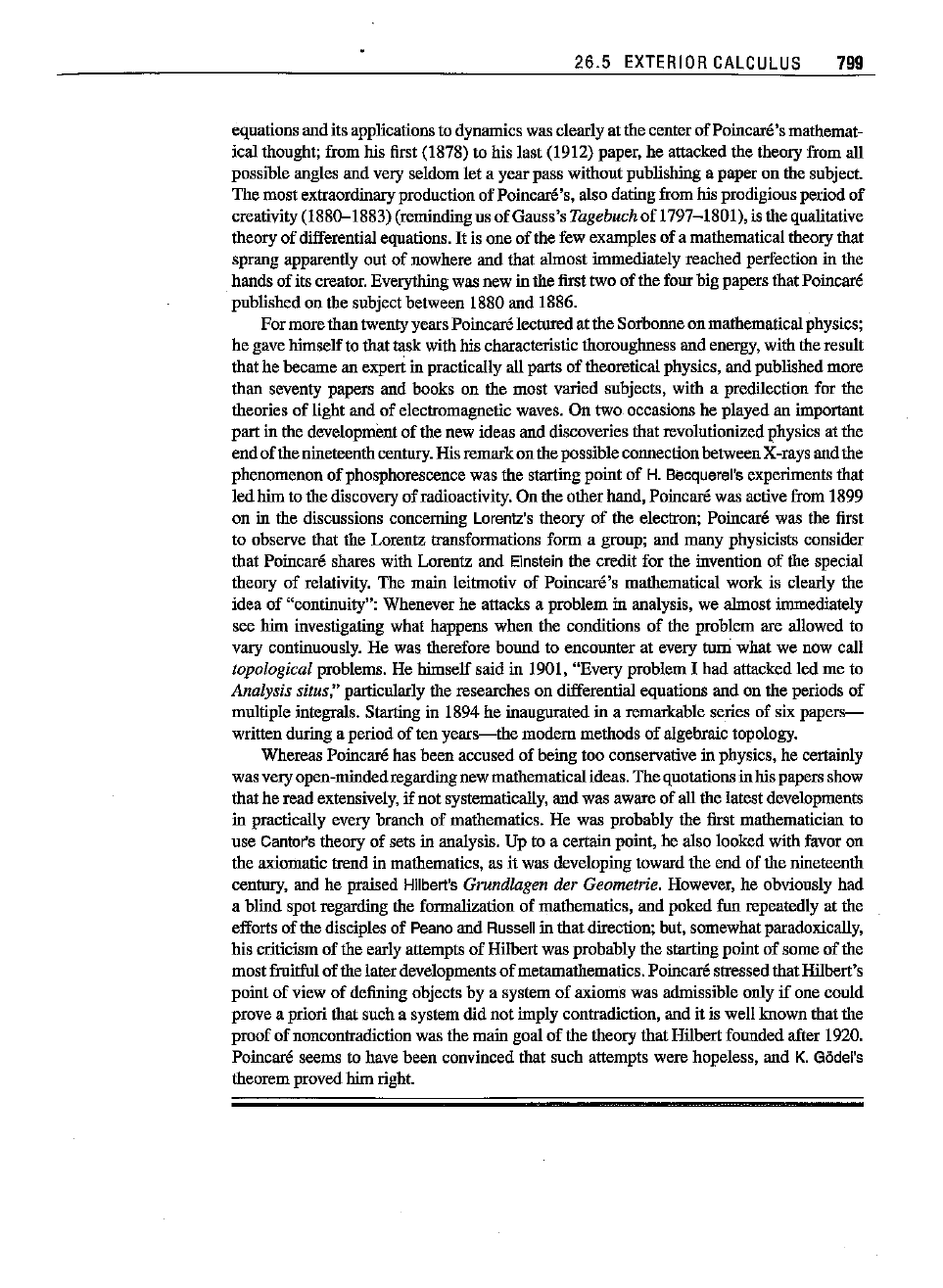
26.5
EXTERIOR
CALCULUS
799
equations
and
its applicationsto dynamics was clearly at the centerofPoincare'smathemat-
ical thought; from his first (1878) to his last (1912) paper, he attacked the theory from
all
possible angles
and
very seldomlet a
year
pass
without publishing a
paper
on the subject.
The
most
extraordinaryproduction
of
Poincare's, also datingfrom his prodigiousperiod
of
creativity
(1880-1883)
(remindingus
of
Gauss's Tagebuch
of
1797-1801),is
the
qualitative
theory
of
differential equations.
It
is
one
of
the few examples
of
a mathematical theory that
sprangapparently out of
nowhere
and that almostimmediately reachedperfection in the
hands
of
its creator. Everything was new in the first two
of
the four
big
papers that poincare
published on the subject between 1880 and 1886.
For
more
thantwentyyearspoincarelecturedat the Sorbonneon mathematicalphysics;
he gave
himself
to
that
task withhis characteristic thoroughness and energy, with the result
that he
became
an expertin practically all parts
of
theoretical physics,
and
published more
than seventy papers and books on the
most
varied subjects, with a predilection for the
theories
of
light and
of
electromagnetic waves. On two occasions he
played
an important
part
in the development
of
the new ideas and discoveries that revolutionized physics at the
end
of
the nineteenthcentury. His
remark
on
the
possibleconnectionbetweenX-rays and the
phenomenon
of
phosphorescence was the starting
point
of
H. Becquerel's experiments
that
led
him to
the
discovery
of
radioactivity. On the
other
hand, poincare was active from 1899
on in the discussions concerning Lorentz's theory
of
the electron; Poincare was the first
to observe that the Lorentz transformations
form
a group; and
many
physicists consider
that poincare shares with Lorentz
and
Einstein the credit for the invention
of
the special
theory
of
relativity. The
main
leitmotiv
of
poincare's
mathematical
work
is clearly the
idea
of
"continuity": Whenever he attacks a
problem
in analysis, we
almost
immediately
see
him investigating what happens
when
the conditions
of
the problem are allowed to
vary continuously. He was therefore
bound
to
encounter
at every
tum
what
we now call
topological problems. He
himself
said
in 1901,
"Every
problem
I
had
attacked
led
me
to
Analysis situs," particularly the researches on differential equations
and
on
the
periods
of
multiple integrals. Starting in 1894 he inaugurated in a remarkable series of six
papers-
written during a period
of
ten
years-the
modem
methods
of
algebraic topology.
Whereas poincare has
been
accused
of
being too conservative in physics, he certainly
was veryopen-mindedregardingnew mathematicalideas.
The
quotations
inhis
papers show
that he read extensively, if
not
systematically,
and
was aware
of
all the latest developments
in practically every branch
of
mathematics. He was probably the first mathematician to
use
Cantor's theory
of
sets in analysis. Up to a certain point, he also looked with favor on
the axiomatic trend in mathematics, as it was developing toward
the
end
of
the
nineteenth
century, and he praised Hilbert's
Grundlagen der Geometric. However, he obviously
had
a
blind
spot regarding the formalization of mathematics,
and
poked
fun repeatedly at the
efforts
of
the disciples of Peano
and
Russell in
that
direction; but, somewhat paradoxically,
his criticism
of
the early attempts
of
Hilbert was probably the starting
point
of
some
of
the
mostfruitful
of
the laterdevelopments
of
metamathematics. poincarestressed
that
Hilbert's
point
of
view
of
defining objects by a system
of
axioms was admissible
only
if
one could
prove a priori that such a system did
not
imply contradiction, and it is
well
known
that
the
proof
of
noncontradiction was the
main
goal
of
the theory
that
Hilbert founded after 1920.
poincare seems to have
been
convinced that such attempts were hopeless,
and
K.Godel's
theorem proved
himright.

•
800 26. ANALYSIS
OF
TENSORS
26.5.1 Integration on Manifolds
integration
of
ditierential
forms
in
JR"
Wementionedin Chapter25 that certainexteriorproducts are interpretedas volume
elements. We now exploitthis notion and define integration on manifolds. Starting
with
JR"
,consideredas a manifold, we define the integralof an n-formwas follows.
Choosea coordinatesystem
{x'}i~l
in
R",
writew
=
fdx
1
A·
..
rcdx",and define
the integral of the
n-form as
~
1.
co
se
1.
f(x
1
,
••.
,
x")dx
1
••.
dx";
R",X
]RII
•
This
discussion
is
analogous
toour
discussion
of
orientation
in
vector
spaces
(see
Section
25.3.2).
orientable
manifolds
where to avoid dealing with infinities, one assumes that f vanishes outside a finite
region. The second symbol in the lower part of the integral sigo indicates the
variables
of
integration.
Let
us now change the coordinates, say to {yJ
}j~l'
Using
Equation (26.17), which gives the transformation rule for I-forms when changing
coordinates, and Equation (25.13), which defines the determinant in terms
of
n-
forms, we obtain
r
1 "
(ax')
1 "
w=fdx
A"'Adx
=fdet
-.
dy
A···Ady,
ayJ
,
where f is now understood to be a function of the
y's
through the
x's.
So, in terms
of the new coordinates, the integral becomes
1.
1
1 n (
ax'
) 1 "
w=
f(x
(y),
...
,x
(y))det
-.
dy
A···Ady.
RII,y RII
8y)
If
we had the absolute value of the Jacobian in the integral, the two sides would
be equal. So, all we can say at this pointis
1.
w=
±1.
w.
R",y Rn,x
We therefore distinguish between two kinds
of
coordinate transformations:
If
the
Jacobian determinant is positive, we say that the coordinate transformation is
orientation
preserving. Otherwise, the transformation is called
orientation
re-
versing.
Our ability to integrate functions on
JR"
depends crucially on the fact that
volume elements do not change sign at any point
of
JR".
If
this were not so, we
could find a finite (albeit small) region
of
space-in
the vicinity
of
the point at
which the volume element changes
sign-whose
volume would be zero. This
property of
JR"
is the content
of
the following:
26.5.16. Definition.
A manifold M
of
dimension n is called orientable
if
it has a
nowhere vanishing n-form.
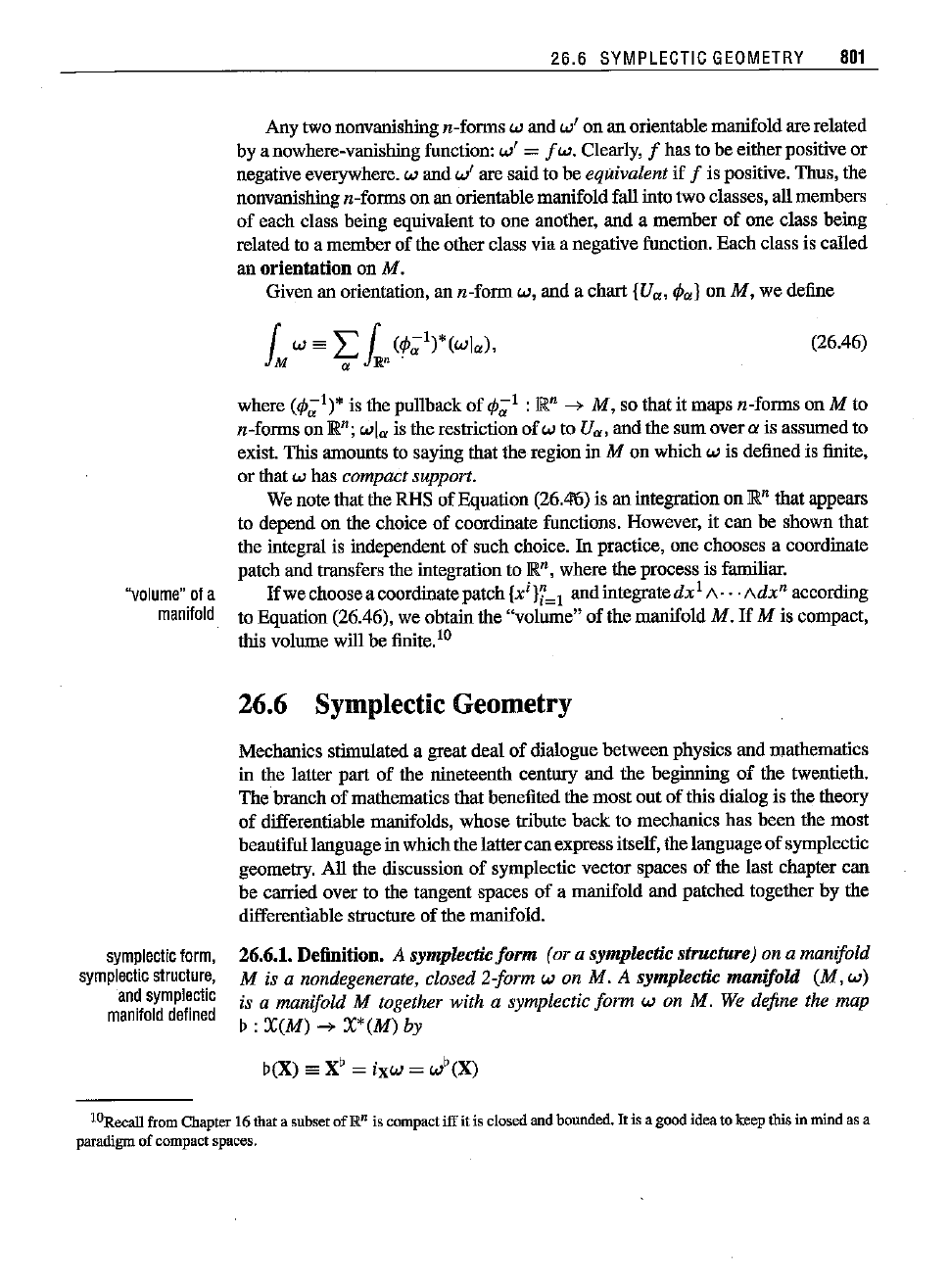
26.6
SYMPLECTIC
GEOMETRY
801
Any two nonvanishing n-forms w and
w'
on an orientable manifoldare related
by a nowhere-vanishing function:
w'
=
fw.
Clearly, f has to be eitherpositive
or
negative everywhere. w and
w'
are said to be equivalent if f is positive. Thus, the
nonvanishing n-forms on an orientable manifoldfall into two classes, all members
of
each class being eqnivalent to one another,
and
a member
of
one class being
related to a member
of
the other class via a negative function. Each class is called
an
orientation
on M.
Given an orientation, an n-form w, and a chart {Va,
<Pal
on M, we define
(26.46)
where
(<p;;I)*
is the pullback
of
<p;;1
:
JR"
--->
M,
so thatit maps n-forms on M to
n-fonns on R";
wl
a
isthe restriction
ofw
to U«,andthesum overa is assumedto
exist. This amounts to saying that the region in M on which w is defined is finite,
or that
w has compact support.
We note that the RHS
of
Equation (26.46) is an integration on
JR"
thatappears
to depend on the choice
of
coordinate functions. However, it can be shown that
the integral is independent
of
such choice.
In
practice, one chooses a coordinate
patch and transfers the integration to
JR",
where the process is familiar.
"volume"
ofa
lfwe
choosea coordinatepatch{xili'=1
and
integrate
dx
1
/\
...
r.dx"
according
manifold
to Equation (26.46), we obtainthe "volume"
of
the manifold
M.
lf
M is compact,
this volume will be finite.10
26.6 Symplectic Geometry
Mechanics stimnlated a great deal
of
dialogue between physics and mathematics
in the latter part
of
the nineteenth century
and
the beginning
of
the twentieth.
The branch
of
mathematics that benefited the
most
out
of
this dialog is the theory
of
differentiable manifolds, whose tribute
back
to mechanics has
been
the
most
beautifullanguage in whichthe lattercan express itself, the language
of
symplectic
geometry. All the discussion
of
symplectic vector spaces
of
the last chapter
can
be carried over to the tangent spaces
of
a manifold and patched together by the
differentiable sttucttue
of
the manifold.
symplectic
form,
symplectic
structure,
and
symplectic
manifold
defined
26.6.1. Definition. A symplectic
form
(or a symplectic structure) on a manifold
M is a nondegenerate, closed 2-form
w on M. A symplectic
manifold
(M,
w)
is a manifold M together with a symplectic form w on M. We define the map
b :
X(M)
--->
X*
(M)
by
b(X) ea
X'
= ixw = w'
(X)
lORecall
from
Chapter
16thata subsetof:R
n
is
compact
iff it is closedand
bounded.
It is agoodideato keepthisin mindasa
paradigm
of compactspaces.
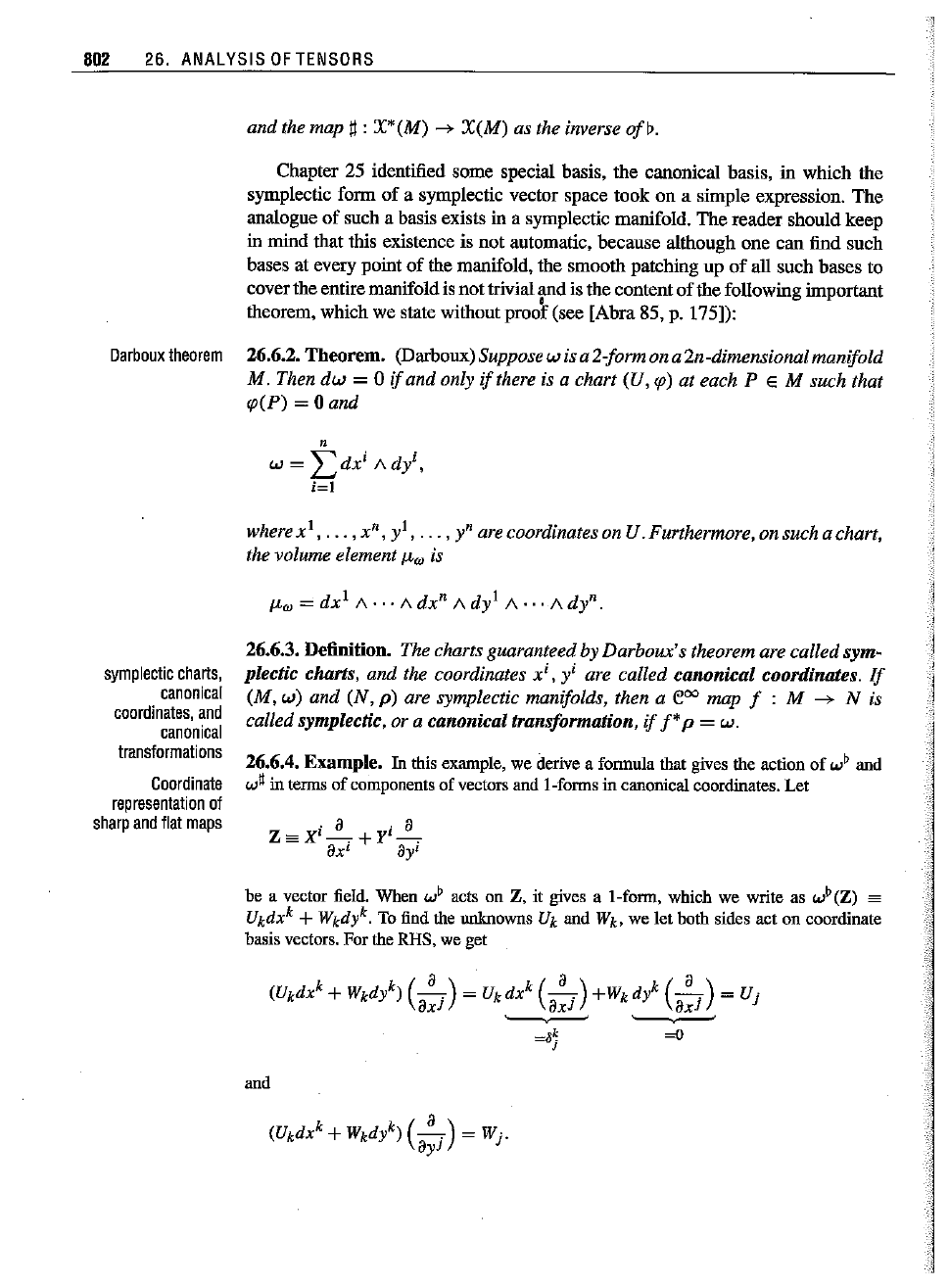
802 26. ANALYSIS
OF
TENSORS
and the map
~
: X*(M)
-->
X(M)
as the inverse of».
Chapter 25 identified some special basis, the canonical basis, in which the
symplectic form
of
a symplectic vector space took on a simple expression.
The
analogue
of
such a basis exists in a symplectic manifold.
The
reader should keep
in miud that this existence is
not
automatic, because although one
can
fiod such
bases at every point
of
the manifold, the smooth patching up
of
all such bases to
cover the entiremanifoldis not trivialand is the content
of
the following important
theorem, which we state without
proo~
(see [Abra 85, p. 175]):
Darboux
theorem
26.6.2.
Theorem.
(Darboux)Supposew isa2-form ona2n-dimensionalmanifold
M. Then
dw
= 0
if
and only
if
there is a chart (U,
rp)
at each P E M such that
rp(P) = 0 and
"
w =
Ldx
i
AdJ',
;=1
where
Xl
,
.••
, x",
yl,
...
, yn are coordinateson U.Furthermore, on such a chart,
thevolumeelementttwis
fL", = dx
1
A
...
A
dx"
A
dyl
A
...
A dy",
symplectic
charts,
canonical
coordinates,
and
canonical
transformations
Coordinate
representation
of
sharpand
flat
maps
26.6.3. Definition. The charts guaranteed by Darboux's theorem are called sym-
plectic charts, and the coordinates
xi,
yi are called canonical coordinates.
If
(M, w) and (N, p) are symplectic manifolds, then a e
oo
map f : M --> N is
called symplectic, or a canonicaltransformation,
if
f* P = w.
26.6.4.
Example.
In this example,we derivea formulathat givesthe action of
w'
and
w
U
intermsof
components
of vectorsandI-formsin canonicalcoordinates. Let
. a . a
Z=X'-.
+Y'-.
ax
'
ay'
be a vector field. When w
D
acts on Z,
it gives a 'l-form, which we write as w
D
(Z) _
Ukdxk +
Wkdi·
To findthe nnknownsUk and
Wko
we let both sides act on coordinate
basisvectors.FortheRHS,we get
and
